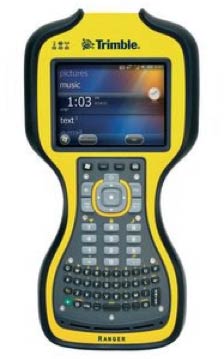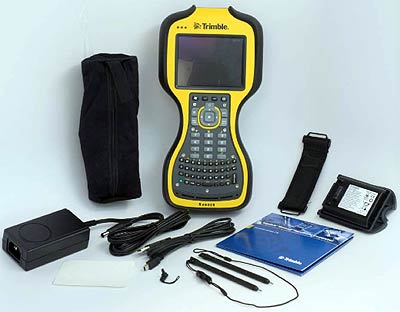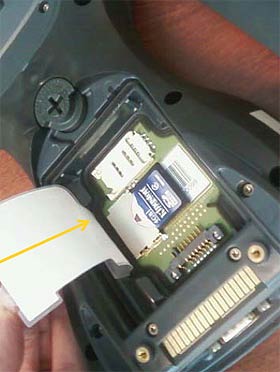|
Trimble Ranger 3
Trimble presents the next generation Ranger
(by Conrad Blickenstorfer)
On January 26, 2011, Trimble introduced the next generation Ranger rugged handheld computer. The Ranger 3 series is the latest in a long line of rugged mobile computers that goes back more than a decade. According to Trimble, the new Ranger 3 is ideal for surveying, construction, field service, forestry, mapping, public safety, utilities, and other outdoor or service-related applications.

Since the new model is presented as a next generation product, here's how new and old differ:
- Operating system -- The Ranger 3 uses Windows Mobile 6.5 Professional versus the older Ranger's Windows Mobile 5.0.
- Processor -- Trimble abandoned Marvell here; instead of the 520MHz PXA270, the new Ranger now has an 800MHz Texas Instruments Sitara AM3715 ARM Cortex-8 chip, a chip that appears very similar to the TI OMAP 3530 used in a number of recent products (like Intermec's 70 Series).
- Memory and Storage -- RAM doubled from 128MB to 256MB; Flash is all the way up from half a gig to a full 8GB.
- Display -- Big improvement here. The old Ranger's 3.8-inch QVGA display has been replaced with a larger 4.2-inch full-VGA screen.
- Size and Weight -- Though the new Ranger 3 is all rounded and curvy, overall dimensions remain virtually unchanged (5.2 x 10.5 x 1.9). The curves, though, add a bit of weight: 2.3 vs. 2.1 pounds.
- Ruggedness -- There really was no need for change and both are tough and rugged. Operating temperature (-22 to 140F), sealing (IP67), drop spec (4 feet), etc., all seem unchanged.
- Power/battery life -- Hard to say. The old Ranger had a massive 6,600mAH Li-Ion that promised 30 hours; the new one has a 11.1 V, 2500 mAh battery, and battery life is given as 34 hours idle, and 17 hours with WWAN in use.
- Connectivity -- The old Ranger provided lots of connectivity via a "PowerBoot" module that combined ports and battery, and there was a top-cap with expansions slots underneath. There is no mention of either a power boot or a top cap for the new Ranger 3.
- Keyboard/pad -- Similar, but not the same. The new Ranger still separates letter and number keypads. The navigation keys have been fine-tuned, but the letter keys now use a curved QWERTY layout instead of the alpha layout of the old Ranger..
- Cool technology -- The new Ranger 3 is not only faster and has a much better display, it also has an accelerometer, an electronic compass, GPS, and optional 5mp camera with flash, laser scanner, and 3G GSM data modem.
It's not immediately obvious whether the Ranger 3 will completely replace the Ranger in Trimble's lineup (which would also affect a number of Trimble distributors and resellers). Technologically, the new model is unquestionably a good step forward in terms of speed, storage, display and use of newly available technology. And clearly, the ability to geotag items as part of field service and logistics applications opens new application potential, as do the accelerometer, compass, etc.
Size, weight and ruggedness apparently suited Trimble's customers and so they remain unchanged. We haven't seen the backside of the unit and how it's constructed, and so we are curious how Trimble handled the move from the old Ranger's PowerBoot/end-cap approach that was geared towards providing a maximum of flexibility and configurability to the Ranger 3's apparently more integrated approach.

As is, the Ranger 3 has a USB and a mini-USB port as well as a 9-pin serial and power jack at the bottom, each with a protective rubber plug. SDHC and SIM card slots are beneath the battery, and there's a headset jack on top. In addition to the available options, accessories include carry cases, battery chargers as well as RAM-Mount mounting systems.
We hope we'll soon be able to report in more detail on the Ranger 3, its performance, and whether the design approach, despite similar looks and dimensions, remains the same or not.
|
|
|
|
Specifications Trimble Ranger 3
|
|
Added/changed
|
Added 01/2011
|
|
Form-factor
|
Rugged handheld computer
|
CPU/Speed
|
Texas Instruments AM3715 Sitara ARM Cortex-8, 800MHz
|
OS
|
Windows Mobile 6.5 Professional
|
RAM/ROM
|
256MB/8GB Flash
|
Card slots
|
1 SDHC (up to 32GB), 1 SIM
|
Display type
|
Sunlight-readable transflective TFT
|
Display size/res
|
4.2"/480 x 640 pixel VGA
|
Digitizer/pens
|
resistive touch/1
|
Keyboard/keys
|
58-key QWERTY keypad with number pad, directional buttons and 4 programmable buttons
|
Navigation
|
Nav pad, onscreen
|
Housing
|
Polycarbonate shell
|
Operating Temp
|
-22 to 140F (-30 to 60C)
|
Sealing
|
IP67
|
Shock
|
26 4-foot drops onto playwood over concrete per MIL-STD-810G, Method 516.6, Procedure IV
|
Tumbles
|
NA
|
Humidity
|
90% relative humidity, temperature cycle -4F/140F per MIL-STD-810G, Method 507.5
|
Altitude
|
15,000 feet at 73F and 40,000 feet at -22F per MIL-STD-810G, Method 500.5, Procedures I, II, III
|
Certifications
|
FCC, CE, R&TTE, IC (Canada), C-tick, GCF compliant, RoHS compliant, Section 508 compliant, AT&T certified, Wi-Fi Alliance certified, MIL-STD-810G, IP67, MIL-STD-461
|
Size (WxHxD)
|
5.2 x 10.5 x 1.9 inches
|
Weight
|
2.3 lbs. with battery
|
Power
|
11.1 V, 2500 mAh, 27.8 Wh Li-ion rechargeable pack ("idle: 33.9 hours, with WWAN in use: 17.2 hours") |
Interface
|
USB host and client, 3.5 mm stereo + mic audio port, dock, 9-pin RS232 serial
|
Wireless
|
Bluetooth ver. 2.0 + EDR, 802.11b/g WiFi, HSDPA 3.6 Mbit/s, Tri-band; HSDPA/UMTS: 850/1900/2100 MHz, Quad-band; GSM/GPRS/EDGE: 850/900/1800/1900 MHz; SiRFstarIII GPS (2-4 meters with SBAS correction); optional: 5mp camera, 1D barcode laser scanner, LED flashlight function
|
List price
|
inquire
|
Contact
|
Ranger 3 product page at Trimble
|
Contact
|
Ranger 3 brochure (PDF)
|
Presentation
|
Ranger 3 presentation (PDF)
|
|
|
Windows CE/Windows Mobile Info
|
Windows Embedded Handheld
Windows Phone 7
Windows Embedded CE 6.0 R3
Windows Mobile 6.5
Windows Mobile 6
Windows CE 6.0
Windows Mobile 5
Windows CE 5.0
Windows Mobile Smartphone
Windows Mobile 2003
Windows CE .Net
Windows for Pocket PC 2002
Pocket PC intro 2000
Windows CE H/PC Pro 1998
Windows CE 2.0 1997
|
|

|
|



